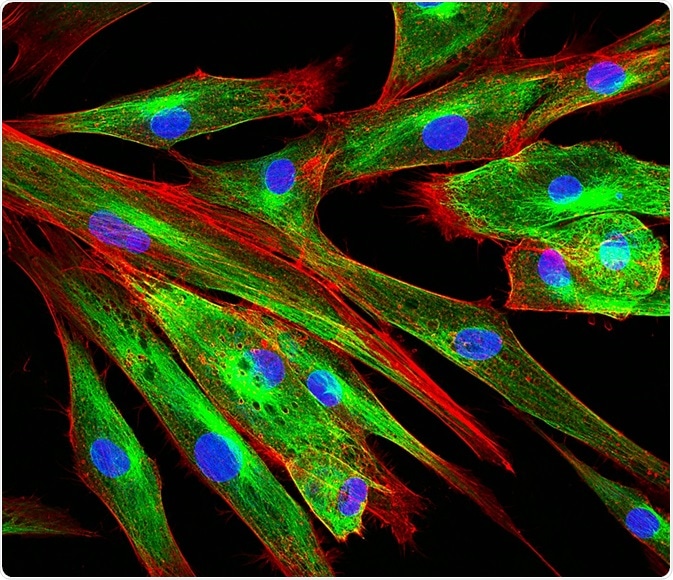The extracellular matrix determines the structure and function of tissue through a complex network of macromolecules.
 Credit: Vshivkova/Shutterstock.com
Credit: Vshivkova/Shutterstock.com
The composition of the extracellular matrix differs between tissue types. Though its main function is to provide an essential scaffold for cells, the extracellular matrix also regulates processes by controlling cell communication.
Cell-extracellular matrix interactions are vital to the structure of tissue and are facilitated by heterodimer molecules. Moreover, the extracellular matrix has an important role in tissue repair which can be utilized as a therapeutic target.
The structure and function of the extracellular matrix
The extracellular matrix is comprised of non-cellular components within tissues that form an essential scaffold for cellular constituents. The structure of the extracellular matrix differs in composition between tissue types but is essentially made up of collagen fibers, proteoglycans and multiadhesive matrix proteins that are secreted by cells.
The functions of the extracellular matrix include:
- Forming an essential support structure for cells.
- Controlling communication between cells.
- Segregating tissues.
- Regulating cell processes such as growth, migration and differentiation.
The extracellular matrix can be divided into two groups, each with a specific structure. The first are called interstitial matrices and surround cells, whilst the second are termed pericellular matrices and are cell-associated.
The basement membrane is an important example of a pericellular matrix found between the functional and connective tissue. The structure provides an anchoring layer that keeps functional tissue cells together. The cells embedded within the extracellular matrix interact through surface receptors and integrate signals from the matrix that are associated with their function.
Furthermore, cells participate in the formation of the extracellular matrix through the secretion of matrix macromolecules. This means that differences in the structure of the extracellular matrix affect the biomechanical properties of the whole network in addition to the signals that transform cell response.
Cell-extracellular matrix interactions
Cell-extracellular matrix adhesion is established through the interaction of cell adhesion molecules binding to the cell surface of the extracellular matrix. Integrins are heterodimer molecules that produce attachments between the cell surface and the extracellular matrix.
Integrins have weak ligand interactions meaning that multiple adhesions to extracellular matrix protein binding sites are required. This weak interaction strength is particularly advantageous for migrating cells.
Cell-extracellular matrix adhesions are formed at two types of integrin-dependent junction: focal adhesions and hemidesmosomes. Focal adhesions occur at the attachment site of the cell cytoskeleton and the fibronectin glycoprotein of the extracellular matrix.
This type of attachment anchors the cell and facilitates signaling across the plasma membrane. Hemidesmosomes connect intermediate filaments to the basal laminae of epithelial cells, therefore supplying a rigid structure to epithelial tissue.
Extracellular Matrix And Interstitial Fluid - What Is The Extracellular Matrix
The extracellular matrix and tissue repair
The mechanism for repairing damaged tissue is dependent on the extracelluar matrix. The regulation of cell types within the extracellular matrix allows for mobilization in areas requiring rebuilt tissue.
The extracellular matrix proteins fibrin, fibronectin and collagen provide structural integrity during the repair, with the fibrin-fibronectin interactions acting as a foundation for cell adhesion and migration. The freshly deposited extracellular matrix can be remodeled to form normal tissue through the cross-linking of collagen fibrils.
The interactions between the cell and the extracellular matrix also affect the level of acute inflammation, re-epithelialization, and contraction when tissue is damaged. These factors promote rapid wound closure meaning that important biological responses for minimizing the risk of infection are dependent on the extracellular matrix.
The ability to control cell-extracellular matrix interactions locally is also an attractive therapeutic target. The matricellular proteins found within the extracellular matrix are an example of a viable target. They provide signals that trigger specific cell activities within the wound and are expressed in high frequencies during development but are absent in normal adult tissue. The controlled expression of matricellular proteins during wound repair can therefore produce localized targeting.
Sources:
- Frantz, C. et al. 2010. The extracellular matrix at a glance, Journal of Cell Science, 123, pp. 4195-4200.
- Theocharis, A.D. et al. 2016. Extracellular matrix structure, Advanced Drug Delivery Reviews, 97, pp. 4-27.
- Lodish, H. et al. Molecular Cell Biology. 4th edition. New York: W. H. Freeman; 2000. Section 22.2, Cell-Matrix Adhesion.
- Midwood, K.S. et al. 2004. Tissue repair and the dynamics of the extracellular matrix, The International Journal of Biochemistry and Cell Biology, 36, pp. 1031-1037.
Further Reading
Last Updated: Jul 19, 2023